Until the second decade of the 19th Century all naval engagements were conducted at point blank range which meant that the number of shots fired was more important than their accuracy. Soon though, developments in the manufacture of guns made engagements at greater range possible and the accuracy of the gunnery superceded reloading speed. During the 1820s the need for a Naval School of Gunnery gained credence in the higher echelons of the Navy and in 1829 Commander George Smith presented a detailed proposal for a school to the Navy Board who accepted it. In June 1830, Commander Smith was appointed as superintendant responsible for the Instruction of Gunners and was provided with HMS Excellent, then moored off the north-west corner of the Dockyard in Portsmouth, as his base.
Excellent was moored such that her port broadside faced Fareham Creek thereby allowing the firing of any guns then within the Navy's possession with little chance of injuring civilians. During the next two years the school under Smith's able leadership established a reputation for professionalism and further, created a tradition whereby the school took on the role of experimental testing whenever new types of guns were offered to the Navy. In 1832 Smith was promoted to Captain and replaced on Excellent by Captain Thomas Hastings. Smith never received another posting and languished on the Captain's list without employment for 18 years before he died aged 60. The original HMS Excellent did not outlast Smith for long, being replaced by HMS Boyne (renamed Excellent) in 1834
Under Hastings HMS Excellent became an independent command and expanded rapidly, soon reaching a complement of 200 officers and men. The school continued to develop it's experimental arm and in 1834 trialled a new way of firing a gun with a percussion cap. The device was shown to be less effective than advertised. Hastings introduced the award of certificates for gunnery at an early stage but up until 1838 the training did not encompass any form of theoretical tuition.
In 1840 an event occurred which secured the position of the school in the minds of even the most sceptical of the older officers. A British squadron had been sent to capture the fortress at Acre which, having at it's disposal 120 guns, should have been more than a match for the Navy. The first broadsides though were murderous and the accuracy displayed by the trained gunners soon won the day. Hastings used this victory to press his case for further involvement in the development of gunnery and even took on trials of armour placed around ships boilers. His gunners blew a hole in the armour with their first shot and followed it by two more through the hole made by the first.
In August 1845 Hastings handed over the command of Excellent to Captain Henry Ducie Chads and left to become Captain of the Andromache where he soon set benchmarks for gunnery. Records show his gunners firing four broadsides in three minutes and twenty-two seconds.
In 1852, the Navy began showing interest in two small mudbanks in Portsmouth Harbour shown on the chart as Waley and by 1853 had purchased them from the Corporation of Portsmouth. For over a decade they did little with their new possession other than to build a pontoon pier to facilitate landing. In the meantime Chads had been succeeded by Captain Sir Thomas Maitland (1854) who in turn passed on the command to Captain RS Hewlett (1857), who was in command when Excellent was again replaced by HMS Queen Charlotte (renamed Excellent). At some later stage she was joined by a second ship HMS Calcutta.
In 1863 Hewlett was succeeded by Captain Astley Cooper Key whose tenure at Excellent marked a period of transition for the Navy. Old practices and equipment were passing out of fashion as iron and steel replaced wood. At the same time the production of accurate rifles forced a need for more training in personal arms and for this a range on land was needed. Whale Island, as it was now called, was still undeveloped but it had been levelled and partially drained, sufficient that a rifle range could be used there. What was also needed was some form of accommodation and in 1864 a brick structure known as The Excellent House that Jack Built was erected by the Navy men themselves.
Shortly thereafter Captain Key gave way to Captain AWA Hood (1866) after falling out with their lordships over the future of gunnery equipment. Hood was followed by Captains H. Boys (1869), T. Brandreth (1874) and F.A. Herbert (1877) but the next significant change to the standing of Excellent began to take shape in 1878 when a Lieutenant Percy Scott joined Excellent to qualify as a Gunnery Lieutenant.
Scott arrived with a passion for gunnery and a reputation for gallantry earned on an expedition up the Congo river under the redoubtable Sir William Hewett VC. He was contemptuous of the state of British gunnery, an opinion shared by some senior officers, including Admiral of the Fleet Sir Edward Seymour. Even so, the Long Course undertaken by Scott had advanced significantly in the past 20 years and now included the calculus and algebra.
Amongst his many talents Scott was a fine athlete but there was no convenient running track he could use. He saw that Whale Island was being extended as a 1000 convicts were dumping soil there from excavations in the Dockyard and persuaded those in charge to level and drain the new land so that Scott could plant grass to form a running surface. This was so successful that Scott began to champion the idea of abandoning Excellent, the ship, and setting up the Gunnery School on the Island instead. This had to wait though for five years until in 1883 Percy Scott returned to Excellent on the instructional staff under Captain J.A. Fisher. Together Scott and Fisher began the process of bringing Excellent on shore. The first purpose built buildings went up in 1886, followed by parade grounds, accommodation blocks and magazines.
In 1890 Scott was appointed Commander of Excellent just in time to witness the end of the old Excellent. The ship was finally paid off in 1891, but it was a further 4 years before the last load of soil was brought over from the dockyard and the railway, which had been built to help the convicts in their work, was demolished.
Thus began the modern Excellent.
As a postscript to this history of the early days of Excellent it is fitting that it end with some further adventures of Percy Scott. In 1899, having been appointed Captain of HMS Scylla, his gunners achieved the phenomenal record of 56 hits out of 70 rounds fired with six 4.7in guns, an unheard of performance. Scott went on to astonish the Naval world when in 1900 as Captain of HMS Terrible, he landed 12-pdr guns, 4.7in guns and even a 6in gun in support of the British Army in their fight with the Boers. This had neccessitated the design and construction of home made land mountings. In April 1903, Percy Scott returned to Excellent once more, but this time as Captain.
HMS Excellent
- A Brief History -
HMS Excellent - Early Days
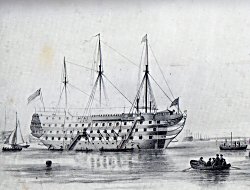
Excellent & Calcutta 1866
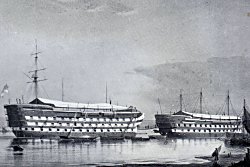
Excellent & Calcutta 1890

Whale Island Rifle Range
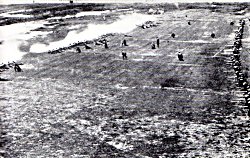
The House That Jack Built
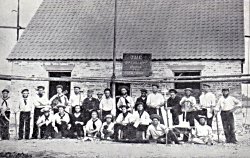
Captain Pearson, Commander Scott
and Staff after the move to
Whale Island
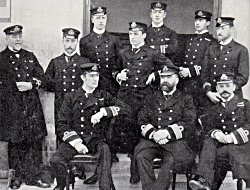

Excellent & Calcutta 1866

Excellent & Calcutta 1890

Whale Island Rifle Range

The House That Jack Built

Captain Pearson, Commander Scott
and Staff after the move to
Whale Island

The Origins of Whale Island/HMS Excellent
